How to Leverage Keyword Cannibalization to Crush Your SEO
Last updated: June 18th, 2018
Does your site have poor traffic and low conversion rates? This is a problem that can really affect your website performance and goals.
In this article, we will discuss what exactly is keyword cannibalization in terms of SEO and how it can negatively impact your website. We will also show you how to potentially reverse the nasty decline, and catapult you into higher positions within the search engine results page.
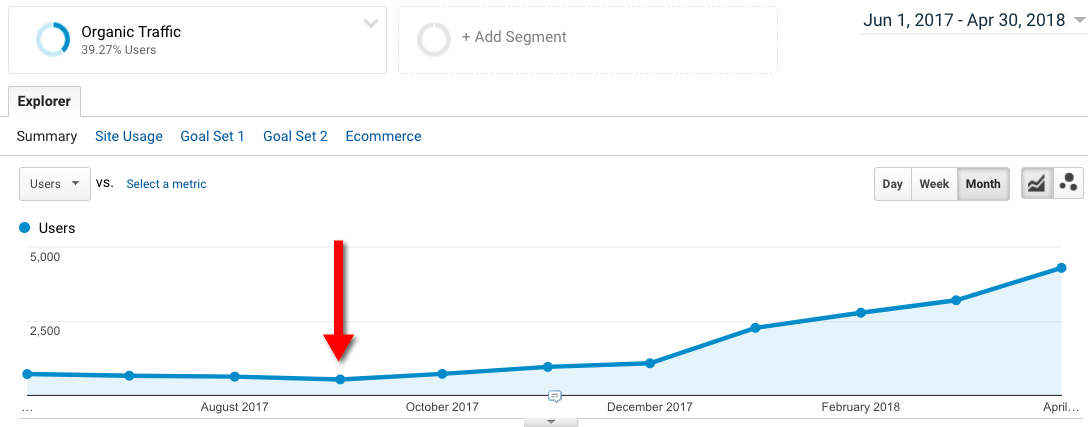
What is keyword Cannibalization?
To put it simply, keyword cannibalization is when a specific keyword is over optimized on multiple pages of your website. This can be harmful because search engines will have a more difficult time determining the best page when a person searches for your topic keyword.
For example, imagine you had a website for your business that sold custom shoelaces and other shoe related accessories. Your website contains lots of unique product pages with different categories, as well as an about page, contact page, and a blog.
What if you optimized for the keyword “custom shoelaces” on almost every single page of your site? Even pages that have little to do with custom shoelaces.
What might happen?
- Google might decide to show the wrong intended page when someone searches for your keyword.
- Perhaps Google may show multiple pages from your website in the SERP.
- Or maybe Google will decide that your pages do not have the proper intent and show none of them.
Is keyword cannibalization bad?
Generally, yes. However, that doesn’t mean you need to panic. Keyword cannibalization is a problem that can easily be fixed, and even used to your advantage to boost traffic and rankings.
The first step is to identify cannibalized keywords and pages
What are some methods to detect keyword cannibalization? The easiest ways are to use tools like Google Analytics, Search Console, ahrefs, or SEMRush.
However, before jumping into any of those tools, it’s a good idea to start by doing a simple site search in Google. Start by typing into the search bar: site:yourdomain.com keyword to check and see which pages you rank for with a specific keyword.
Replace the “yourdomain.com” with your website domain and “keyword” with any keyword you want to track.

This will pull up all pages in Google from your website that rank for a certain topic or keyword. From here, you can get an idea of the types of pages that you rank for. The order in which they are displayed are ranked by a few different factors, including page rank and URL structure.
SEO’s should be familiar with Google operators such as doing a site: search because you can learn valuable insights, especially when it comes to how your site is being indexed. The best part is you don’t need an expensive subscription to do so!
Another way to gather information about keyword cannibalization for free is by using Google Analytics and Search Console.
In this example, we’ll take a look at a cannibalized keyword that the Powered By Search website ranks for. Let’s take a look at the keyword, “SEO landing page” and see how it ranks.
By typing in the keyword into Google, we can see there is a problem already:
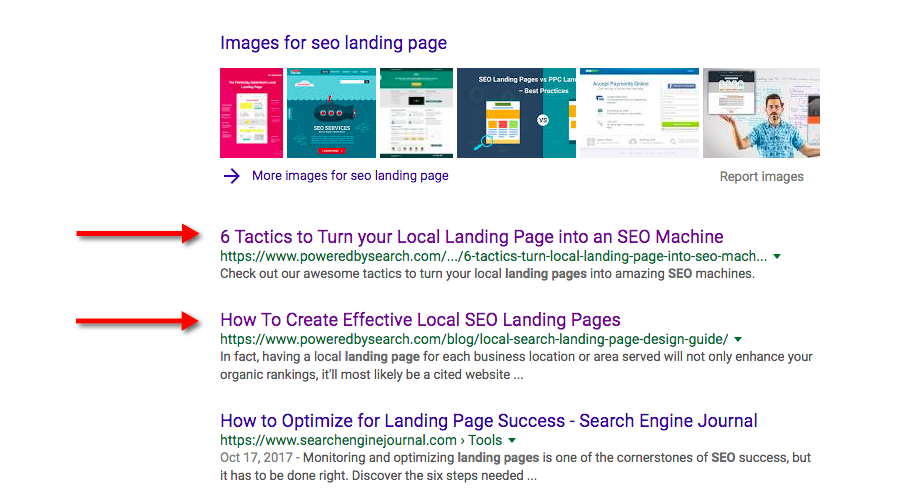
There are two pages ranking in the SERP for the keyword SEO landing page. Both pages are based on the same topic, and are pretty similar in nature. They also both rank on Page 2 of Google.
Let’s take a look at the data for this query and also the two pages in Search Console and ahrefs.
First off, we will pull up the query and pages in search console:
Search Traffic > Search Analytics
On this screen, you will see various analytics based around Queries, Pages, Countries, Devices, Search Type, and Dates. For this example, we’ll want to have Queries selected to see the list of keywords which your website ranks for.

After finding the query for SEO landing page, we will click that result. The next screen will show search analytics for the query you selected. To view which pages are associated with that query, click on the Pages radio button.
After the page refreshes, you should now see data on which pages rank for the keyword SEO landing page. We also want to make sure that we have the options selected for: Clicks, Impressions, CTR, and Position. Having these boxes checked will give you better insights about which page is performing better.
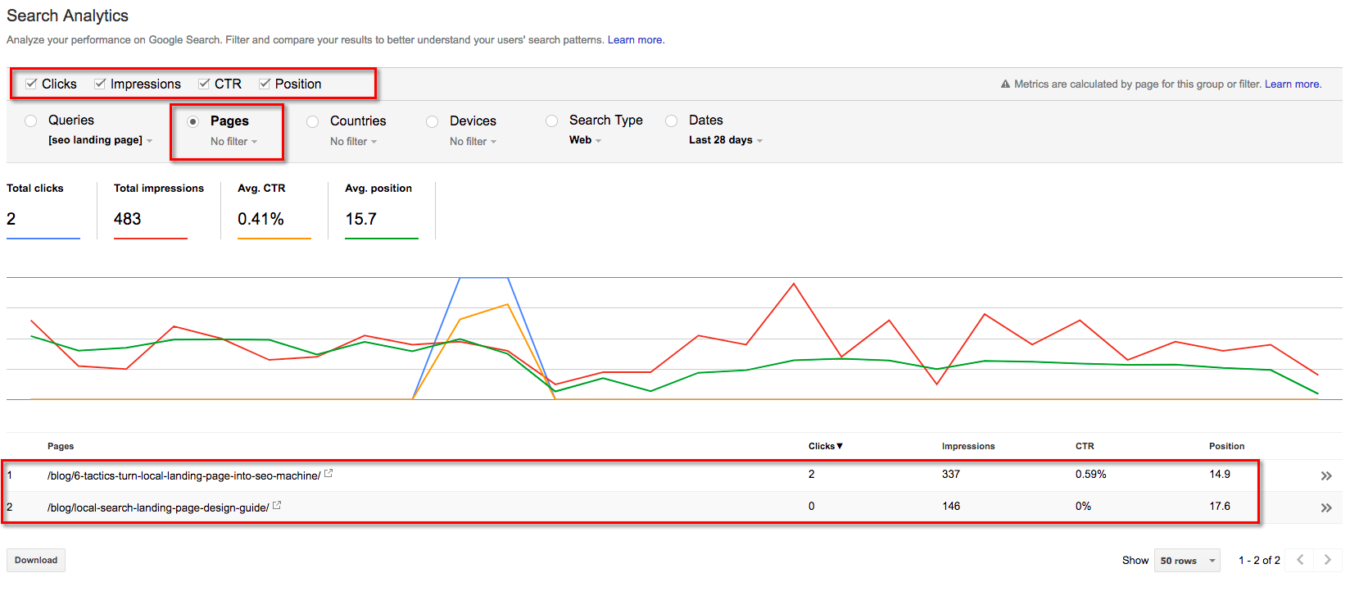
From this image, we can see that page 1 on the list is outperforming page 2, although not by much. This will give us some direction in terms of which pages we should take action on.
Ahrefs Cannibalization Spreadsheet
Another way for detecting keyword cannibalization is through using a tool created by Ahrefs. Although Ahrefs requires a monthly subscription, I would highly recommend investing in it if you’re serious about SEO.
This next method involves using the Ahrefs tool in combination with a fancy Google Sheet template. You can download the spreadsheet here.
Please note that you must make a copy of the spreadsheet by going to File > Make a copy… then saving the template in one of your own Google Drive folders. Do not request edit access!
Quick steps to run the cannibalization spreadsheet:
- Sign into the Ahrefs tool and type in your domain name.
- Navigate to the Organic Keywords menu link.
- Export and download ALL of your organic keywords into a CSV file.
- Open up your template in Google sheets and highlight the cell A1 under the 1. ahrefs KW export tab.
- Go to File > Import… and select the CSV file which you downloaded from ahrefs containing your keywords.
- Select the option “Replace data at selected cell” under Import location.
- Let the spreadsheet run its formulas and view the output on the Results tab.
The spreadsheet is very simple to use, but only if you have an ahrefs subscription unfortunately. For a more detailed set of instructions on how to use the template, visit the original post done on ahrefs.
Viewing the data on the Results tab will look something like this:
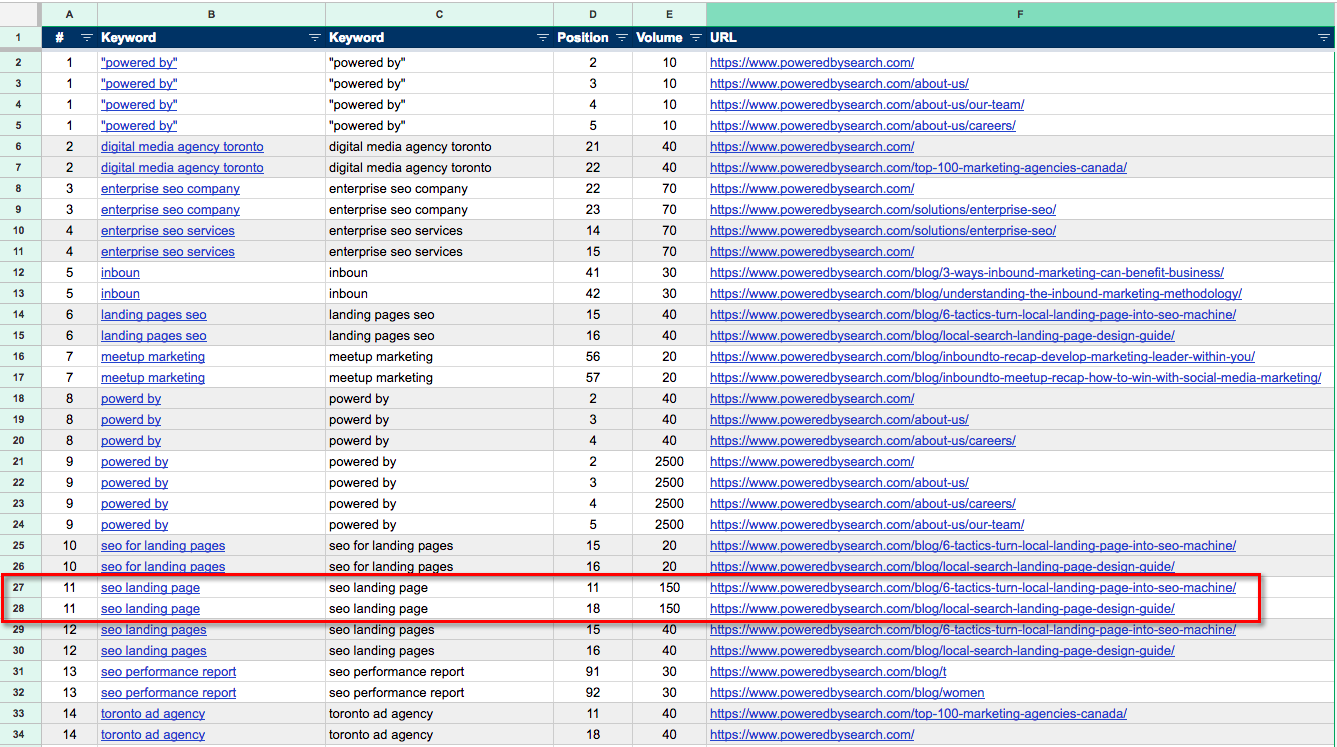
In a nutshell, the spreadsheet works its magic and displays keywords that might have cannibalization issues. Highlighted by the red box is our term “seo landing page” from our previous example. This is probably the faster ways to detect potential cannibalization issues at a high level for your entire website.
Fix pages that you have determined suffer from Keyword Cannibalization
So now that you have all this data about pages that are being cannibalized, what can you do about it?
There are a few good options:
- Update the cannibalized pages
- Take a deeper look into the data
- Purge underperforming pages with thin content
Update the cannibalized pages
- Decide on a page you want to fix.
- Check which additional keywords this page might rank for. If you notice it ranks for other things aside from your cannibalized keyword, add the keyword and the page its on to a list.
- Look at the traffic data on the pages on your list. Select pages that get the best mixture of clicks and impressions out of the bunch.
- Start updating the pages that have the most promising data by removing cannibalized keywords, while emphasizing on new keywords to change up the intent of the page.
Some of the possible places to update your new keywords include: URL path, header tags, alt text on images, and of course the actual written content.
Take a deeper look into the data
Sometimes you will come into a situation where you have pages being cannibalized that are very similar. When this happens, it can be a good idea to consolidate these pages into one.
First determine which is the strongest page for the desired keyword. You can do this by examining traffic and click-through-rates as well as by looking at their backlink profiles. Once the stronger page has been determined, this will become your master page for the keyword. Next, take bits and pieces that may be relevant or unique from the pages ready for the chopping block and update your master page with this information.


These two images show the link profile and approximate organic traffic. They are both similar, but the top page ranks for more keywords, and gets more traffic. If we combined these pages, we would also be able to consolidate their backlinks and referring domains. With 7 referring domains (4+3) and 23 backlinks(7+16), we might be able to boost the newly updated content from page 2, to page 1.
By doing this, you are doing two things which are positives in the eyes of Google. First off, you are removing stale, less relevant content. Secondly, you are updating a better performing page with more information while removing its internal competition.
After you have removed the older pages, 301 redirect their extinct URL to your master page URL. By doing this, you may pass authority to your new page to give it somewhat of a boost.
This strategy works even better if those pages being removed have links pointing towards them. The more links, the better. This is also a valuable strategy that can be used small to medium sized websites, as well as Enterprise level sites to gain major rankings.
Purge underperforming pages with thin content
By constantly reviewing your pages, their rankings, and traffic volumes, you can not only identify pages being cannibalized, but pages that are very thin in terms of content.
One of the most talked about SEO strategies in 2017/2018 has been page consolidation and removal of thin content.
This is a strategy we have tested and effectively used to increase traffic and conversions for our clients. It is a completely white hat strategy with little risk, which also aligns with our content approach at Powered By Search.
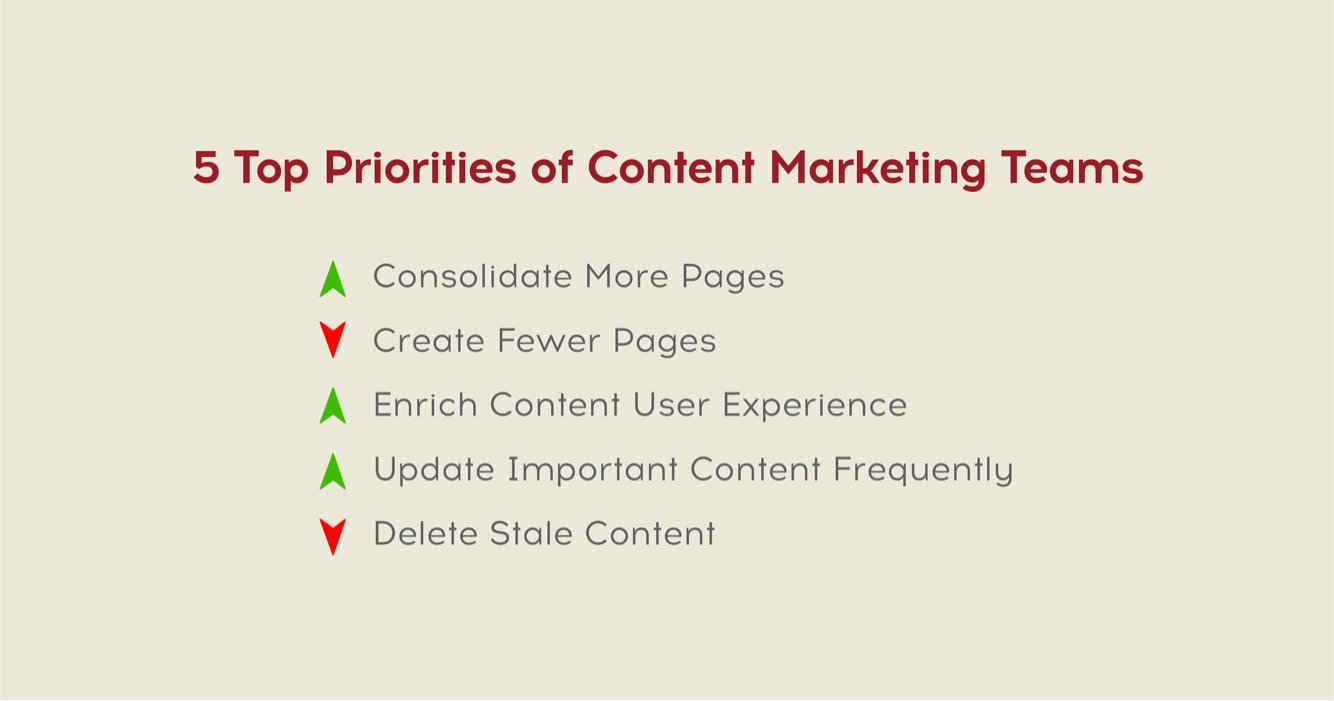
Alternatively, if you do not want to delete or remove pages, you can either noindex them or add a canonicalization meta tag pointing towards your master page.
By adding a noindex tag to your cannibalized content, the search engines will not show that page in the SERP. Use this tactic if you still want to keep the cannibalized content, but do not want it showing up in search.
Another tactic would be to add a rel canonical tag. Again, if you want to keep your content rather than completely removing it, or repurposing it, this is a viable option. Adding a canonical tag will allow you to tell search engines there is a master page which should be ranked instead.
Good problems to have: What if you have multiple pages ranking in the top positions for a keyword?
Dominating the top 3 positions with your pages is never a bad thing. It is estimated that the top three positions in Google receive approximately 50% of the click-through traffic. So if you have multiple pages ranking near the top, even for the same keyword, it’s probably best to leave those pages be and let them gobble up all those clicks.
Need some actual social proof?
The proof is in the pudding as some say. We have been applying this strategy to some of our clients and have seen fantastic results.
At the start of October 2017, we identified cannibalized service and local pages for one of our clients. We used the strategies outlined in this article to put a plan in motion and break up the pages into better silos with more focused intent which eliminated cannibalization.

The result? Almost +600% increase in targeted organic traffic from October 2017 to the end of April 2018.

Their rankings increased significantly over a few short months which resulted in significant traffic growth. The average CTR also nearly doubled from 4.2% to 8%.

To summarize, keyword cannibalization can definitely become a problem if left unattended. However, if you put in the time to research and action the affected pages, you can reverse the decline of traffic and rankings. A strategic approach can push you forward in the search engine results page significantly.
What you should do now
Whenever you’re ready…here are 4 ways we can help you grow your B2B software or technology business:
- Claim your Free Marketing Plan. If you’d like to work with us to turn your website into your best demo and trial acquisition platform, claim your FREE Marketing Plan. One of our growth experts will understand your current demand generation situation, and then suggest practical digital marketing strategies to hit your pipeline targets with certainty and predictability.
- If you’d like to learn the exact demand strategies we use for free, go to our blog or visit our resources section, where you can download guides, calculators, and templates we use for our most successful clients.
- If you’d like to work with other experts on our team or learn why we have off the charts team member satisfaction score, then see our Careers page.
- If you know another marketer who’d enjoy reading this page, share it with them via email, Linkedin, Twitter, or Facebook.
